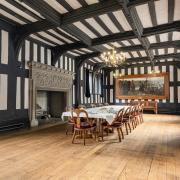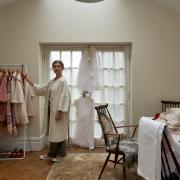While the Battle of Britain was fought largely in the skies above the south-eastern corner of England, as Spitfires and Hurricanes sought to stop German raiders crossing the Channel and heading towards the capital, the men who fought it were drawn from across the country.
The fewer than 3,000 aircrew who took on the Luftwaffe in the summer and early autumn of 1940 came from all points of the compass and all walks of life, with the men of Cheshire playing their part in the battle that changed history.
One of those who hailed from this part of the country went on to have a distinguished post-war career that culminated in him reaching the rank of Air Chief Marshal, serving as the RAF’s Commander-in-Chief in Germany, and winning multiple decorations for his bravery and leadership skills. Christopher (later Sir Christopher) Foxley-Norris, born in Birkenhead on March 16, 1917, also went on serve as chairman of the Battle of Britain Fighter Association – one of the most exclusive clubs in the country – and as the first president of the Battle of Britain Memorial Trust.

His name is now inextricably linked with the trust as he and his wife Joan, Lady Foxley-Norris, funded the Christopher Foxley-Norris Memorial Wall at the Battle of Britain Memorial at Capel-le-Ferne in Kent. The black granite wall lists the names of all those known to have qualified for the Battle of Britain Clasp to the 1939-45 Star campaign award.
It was erected in 2005, but it was not the first tribute to be unveiled at the peaceful clifftop site, which stands on Kent’s famous white cliffs just outside the town of Folkestone and a few miles from Dover.
It was in July 1993 that the National Memorial to the Few, an enigmatic stone carving of an airman looking out across the Channel towards France, was unveiled by Her Majesty Queen Elizabeth The Queen Mother.

The weather was appalling, so much so that as the royal helicopter made its way towards the memorial, the pilot is said to have turned to the Queen Mother with the words: 'The weather is getting worse, Your Majesty. Should we turn back?' Her Majesty is said to have replied: 'My boys never turned back. We press on.'
Apocryphal or not, the story illustrates both the Queen Mother’s indomitable spirit and that of the airman commemorated by the memorial she went on to unveil that day.
Thirty years on, the Memorial to Foxley-Norris and his fellow aircrew has grown considerably, with the most dramatic addition being a modern visitor centre, The Wing, opened in 2015 by Her Majesty Queen Elizabeth II and His Royal Highness Prince Philip, Duke of Edinburgh. Built in the shape of a Spitfire wing, it contains the high-tech Scramble Experience, which aims to bring the battle to life for all ages.
Despite caring for the ‘National’ Memorial to the Few and attracting royal support (HRH Prince Michael of Kent GCVO has been patron for the past 20 years), the trust receives no public funding and has to rely on its own fundraising efforts to survive.
The memorial was the brainchild of Wing Commander Geoffrey Page, DSO, OBE, DFC and bar, who, as a Pilot Officer during the battle, was shot down in flames and badly burned, becoming one of renowned surgeon Sir Archibald McIndoe’s ‘guinea pigs’ at the Queen Victoria Hospital in East Grinstead.
Years later Page realised there was no national tribute to the men with whom he had served and persuaded a group of like-minded people to help put that right. The trust was born.
To qualify as one of ‘the Few’, the term coined by Prime Minister Winston Churchill when he told the House of Commons, on August 20, 1940: 'Never in the field of human conflict was so much owed by so many to so few', aircrew had to fly at least one authorised operational sortie with an accredited squadron or unit of RAF Fighter Command between July 10 and October 31, 1940.

The dates were to a large extent arbitrary, as Air Chief Marshal Sir Hugh Dowding, who fixed them, admitted, but they have become accepted. A pilot – or air gunner, observer or radar operator – who tangled with any number of enemy aircraft on July 9 or November 1 would not win the coveted clasp.
Those who did win it included another Cheshire man, Frederick William Eley, who was born in 1919 and flew Spitfires during the Battle of Britain.
In his early years, Eley lived at Cholmondeston Hall Farm near Wettenhall, where his father was a dairy farmer. After the business failed and his mother died, he went to live with the family of his cousin Brian George in nearby Aston.
On leaving school Eley worked for Lloyds Bank, and in the spring of 1939 he joined the RAF Volunteer Reserve at Tern Hill near Market Drayton. He was called up on September 1 and, after finishing his training, joined No 74 squadron at Rochford in Essex.
It was not until July 31, a day of Luftwaffe attacks on shipping and the Dover balloon barrage, that 74 lost pilots in action. It was late afternoon when the squadron took on Messerschmitt Bf109s over Dover and suffered three casualties, including Fred Eley’s Spitfire, which went down in flames off Folkestone harbour.
Eley is thought to have been a victim of the vastly more experienced Oberleutnant Horst ‘Jakob’ Tietszen, a veteran of the Spanish civil war. Boatmen and service personnel brought the British fighter ashore and Eley’s body was recovered from the cockpit. Tietszen survived less than three weeks longer, being shot down on August 18, probably by the Polish Pilot Officer Zenker of No 501 Squadron.
Eley is remembered in St Margaret's Church, Wrenbury-cum-Frith, where a stained glass window remembers eight of the village’s Second World War dead. They are also listed in a book of remembrance. Eley is buried in the churchyard.
PO Zenker is one of 145 Polish names on the Christopher Foxley-Norris Memorial Wall, where the names are listed without rank or decoration, highlighting the bravery of all those who flew. Aces who became household names, such as Douglas Bader, stand alongside those who were lost on their first sortie.
The names are a reminder that aircrew from across the Commonwealth, occupied countries and the United States joined the fight for freedom; it is simply not true that Britain ‘stood alone’, although it is certainly true that if the RAF had lost the fight, the south coast could not have been used as the springboard for the D-Day landings four years later and the war may have lasted considerably longer.
Until a few years ago many of the Few, sadly now no longer with us, were enthusiastic supporters of the trust and its work and regularly attended events at Capel-le-Ferne.

They included Owen Burns, who was born in Birkenhead in 1915 and educated at St Francis Xavier’s College, Liverpool. He trained as a wireless operator/air gunner and joined No 235 Squadron at Bircham Newton in June 1940, carrying out airfield protection duties and escorting aircraft attacking French ports and German shipping. On an offensive sweep on November 18, he shot down a Dornier Do18 flying boat.
Returning from a dusk patrol over the North Sea on February 14, 1941, Burns’s Bristol Blenheim hit a tree as it was about to land without flarepath lights, which had been extinguished because enemy aircraft were in the vicinity. The observer was killed and the pilot seriously injured, but Burns, who died in June, 2015, just a few months short of his 100th birthday, escaped with a broken collarbone.

It is because the memorial pays tribute to observers, air gunners and radar and wireless operators that the trust is careful to refer to ‘aircrew’ rather than pilots. That inclusivity was important to another Cheshire airman, Kenneth Roy Lusty, who was born in Sale in 1920 and joined the RAF, again to train as an air gunner, the day after hostilities broke out.
Lusty, who acquired the nickname ‘Lucky’ after a German bullet passed through his sleeve without wounding him, qualified for the clasp flying in Blenheims with No 25 Squadron.
In later life he was determined people should acknowledge the contribution made by those who were not pilots. On one occasion, at a formal dinner, he rose to his feet furiously in the middle of the main speech to reprimand the speaker for referring to “Battle of Britain pilots”. Lusty died in 2009.

Other Cheshire aircrew commemorated at the clifftop memorial, which is also home to other attractions such as replica Spitfire and Hurricane aircraft, include Cyril Bamberger, born in Port Sunlight, who flew Spitfires with No 610 Squadron in the Battle of Britain and also volunteered to serve in Malta, reckoned by many to be an even tougher challenge. He was awarded a DFC and Bar during a distinguished career and is remembered on a plaque unveiled at St John Plessington Catholic College, Bebington, in 2011.
For more information on the Battle of Britain Memorial, see battleofbritainmemorial.org



























